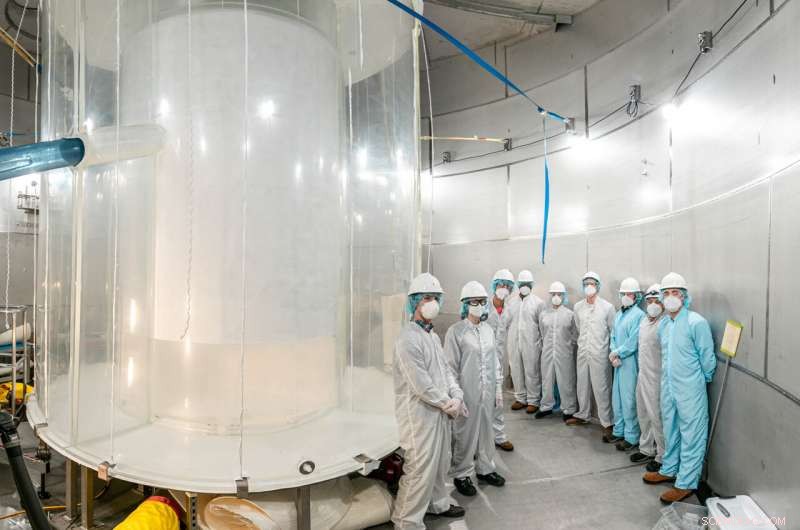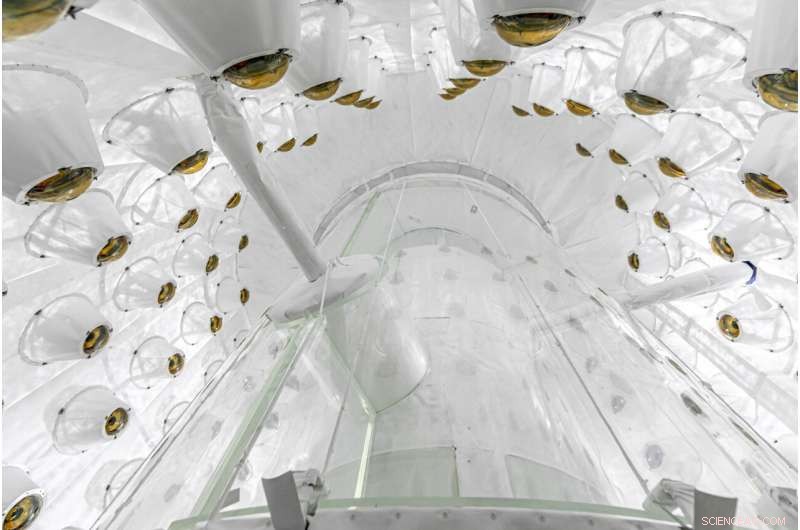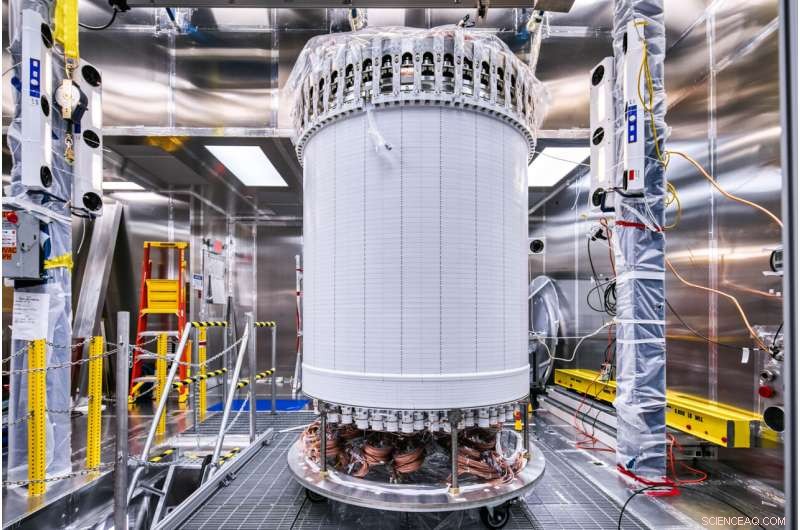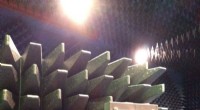Forskere registrerer vellykket opstart af mørk stofdetektor ved underjordisk forskningsfacilitet

Medlemmer af LZ-teamet i LZ-vandtanken efter den ydre detektorinstallation. Kredit:Matthew Kapust/Sanford Underground Research Facility
Dybt under Black Hills i South Dakota i Sanford Underground Research Facility (SURF) har en innovativ og unikt følsom mørkt stofdetektor – LUX-ZEPLIN (LZ) eksperimentet, ledet af Lawrence Berkeley National Lab (Berkeley Lab) – bestået en check-out fase af opstart og leverede første resultater.
Beskeden med hjem fra denne succesrige startup:"Vi er klar, og alt ser godt ud," sagde seniorfysiker og tidligere LZ-talsmand Kevin Lesko i Berkeley Lab. "Det er en kompleks detektor med mange dele, og de fungerer alle godt inden for forventningerne," sagde han.
I et papir udgivet online i dag på eksperimentets hjemmeside rapporterer LZ-forskere, at med den indledende kørsel er LZ allerede verdens mest følsomme detektor for mørkt stof. Bladet vil blive vist på online-fortryksarkivet arXiv.org senere i dag. LZ talsmand Hugh Lippincott fra University of California Santa Barbara sagde:"Vi planlægger at indsamle omkring 20 gange flere data i de kommende år, så vi er kun i gang. Der er en masse videnskab at lave, og det er meget spændende."
Partikler af mørkt stof er faktisk aldrig blevet opdaget - men måske ikke meget længere. Nedtællingen kan være startet med resultater fra LZ's første 60 "live dage" med test. Disse data blev indsamlet over en periode på tre og en halv måned med indledende operationer, der begyndte i slutningen af december. Dette var en periode lang nok til at bekræfte, at alle aspekter af detektoren fungerede godt.
Usynligt, fordi det ikke udsender, absorberer eller spreder lys, er mørkt stofs tilstedeværelse og tyngdekraft ikke desto mindre fundamentalt for vores forståelse af universet. For eksempel former tilstedeværelsen af mørkt stof, anslået til at være omkring 85 procent af universets samlede masse, formen og bevægelsen af galakser, og det påberåbes af forskere for at forklare, hvad der er kendt om den store struktur og ekspansion af universet.

Kigger op i den ydre LZ-detektor, der bruges til at nedlægge veto mod radioaktivitet, der kan efterligne et mørkt stof-signal. Kredit:Matthew Kapust/Sanford Underground Research Facility
Hjertet i LZ-detektoren for mørkt stof består af to indlejrede titaniumtanke fyldt med ti tons meget ren flydende xenon og set af to arrays af fotomultiplikatorrør (PMT'er), der er i stand til at detektere svage lyskilder. The titanium tanks reside in a larger detector system to catch particles that might mimic a dark matter signal.
"I'm thrilled to see this complex detector ready to address the long-standing issue of what dark matter is made of," said Berkeley Lab Physics Division Director Nathalie Palanque-Delabrouille. "The LZ team now has in hand the most ambitious instrument to do so."
The design, manufacturing, and installation phases of the LZ detector were led by Berkeley Lab project director Gil Gilchriese in conjunction with an international team of 250 scientists and engineers from over 35 institutions from the US, UK, Portugal, and South Korea. The LZ operations manager is Berkeley Lab's Simon Fiorucci. Together, the collaboration is hoping to use the instrument to record the first direct evidence of dark matter, the so-called missing mass of the cosmos.
Henrique Araújo, from Imperial College London, leads the UK groups and previously the last phase of the UK-based ZEPLIN-III program. He worked very closely with the Berkeley team and other colleagues to integrate the international contributions. "We started out with two groups with different outlooks and ended up with a highly tuned orchestra working seamlessly together to deliver a great experiment," Araújo said.
An underground detector
Tucked away about a mile underground at SURF in Lead, S.D., LZ is designed to capture dark matter in the form of weakly interacting massive particles (WIMPs). The experiment is underground to protect it from cosmic radiation at the surface that could drown out dark matter signals.

(Left) A schematic of the LZ detector. (Right) Illustration of LZ operation—particles interact in liquid xenon, releasing a flash of light and charge that are collected by photomultiplier tube arrays at top and bottom. Credit:Left schematic:LZ collaboration. Right image:LZ/SLAC
Particle collisions in the xenon produce visible scintillation or flashes of light, which are recorded by the PMTs, explained Aaron Manalaysay from Berkeley Lab, who as physics coordinator, led the collaboration's efforts to produce these first physics results. "The collaboration worked well together to calibrate and to understand the detector response," Manalaysay said. "Considering we just turned it on a few months ago and during COVID restrictions, it is impressive we have such significant results already."
The collisions will also knock electrons off xenon atoms, sending them to drift to the top of the chamber under an applied electric field where they produce another flash permitting spatial event reconstruction. The characteristics of the scintillation help determine the types of particles interacting in the xenon.
Mike Headley, executive director of SURF Lab, said, "The entire SURF team congratulates the LZ Collaboration in reaching this major milestone. The LZ team has been a wonderful partner and we're proud to host them at SURF."
Fiorucci said the onsite team deserves special praise at this startup milestone, given that the detector was transported underground late in 2019, just before the onset of the COVID-19 pandemic. He said with travel severely restricted, only a few LZ scientists could make the trip to help on site. The team in South Dakota took excellent care of LZ.
"I'd like to second the praise for the team at SURF and would also like to express gratitude to the large number of people who provided remote support throughout the construction, commissioning and operations of LZ, many of whom worked full time from their home institutions making sure the experiment would be a success and continue to do so now," said Tomasz Biesiadzinski of SLAC, the LZ detector operations manager.

The LZ central detector in the clean room at Sanford Underground Research Facility after assembly, before beginning its journey underground. Credit:Matthew Kapust, Sanford Underground Research Facility
"Lots of subsystems started to come together as we started taking data for detector commissioning, calibrations and science running. Turning on a new experiment is challenging, but we have a great LZ team that worked closely together to get us through the early stages of understanding our detector," said David Woodward from Pennsylvania State University, who coordinates the detector run planning.
Maria Elena Monzani of SLAC, the Deputy Operations Manager for Computing and Software, said, "We had amazing scientists and software developers throughout the collaboration, who tirelessly supported data movement, data processing, and simulations, allowing for a flawless commissioning of the detector. The support of NERSC [National Energy Research Scientific Computing Center] was invaluable."
With confirmation that LZ and its systems are operating successfully, Lesko said, it is time for full-scale observations to begin in hopes that a dark matter particle will collide with a xenon atom in the LZ detector very soon. + Udforsk yderligere
A major milestone for an underground dark matter search experiment
 Varme artikler
Varme artikler
-
 Astronomer samler lys-fingeraftryk for at afsløre mysterier i kosmosJorden med albedoen tegnet over sig. Kredit:Jack Madden/NASA Jordbundne detektiver er afhængige af fingeraftryk for at løse deres sager; nu kan astronomer gøre det samme, ved at bruge lette-finger
Astronomer samler lys-fingeraftryk for at afsløre mysterier i kosmosJorden med albedoen tegnet over sig. Kredit:Jack Madden/NASA Jordbundne detektiver er afhængige af fingeraftryk for at løse deres sager; nu kan astronomer gøre det samme, ved at bruge lette-finger -
 Ny forskning ser på neutronstjerneeksplosionerProfessor Chris Fragile. Kredit:College of Charleston Røntgenudbrud er højenergiske frigivelser af stråling fra neutronstjerners overflader, udløst af eksplosiv afbrænding af materiale ophobet på
Ny forskning ser på neutronstjerneeksplosionerProfessor Chris Fragile. Kredit:College of Charleston Røntgenudbrud er højenergiske frigivelser af stråling fra neutronstjerners overflader, udløst af eksplosiv afbrænding af materiale ophobet på -
 Sådan fungerer EZ-RocketSet ovenfra på EZ-raketten. Se flere EZ-Rocket-billeder. Foto høflighed XCOR Aerospace At gå i rummet er dyrt - omkring $ 10, 000 pr pund, faktisk. Så indtil for nylig, kun regeringer havde råd til
Sådan fungerer EZ-RocketSet ovenfra på EZ-raketten. Se flere EZ-Rocket-billeder. Foto høflighed XCOR Aerospace At gå i rummet er dyrt - omkring $ 10, 000 pr pund, faktisk. Så indtil for nylig, kun regeringer havde råd til -
 Billede:AnkerantenneKredit:European Space Agency Denne patch-antenne, der testes i ESAs tekniske hjerte, er designet til at opretholde en radioforbindelse mellem de to satellitter, der udgør Proba-3-missionen, tillad
Billede:AnkerantenneKredit:European Space Agency Denne patch-antenne, der testes i ESAs tekniske hjerte, er designet til at opretholde en radioforbindelse mellem de to satellitter, der udgør Proba-3-missionen, tillad
- Kommunale obligationsrenter viser, at investorer er villige til at betale præmie for gæld, der adr…
- NASA analyserer den tropiske storm Wukongs jordbærform
- Ford Backhoe Specifikationer
- Kystrisici og arealudnyttelsespolitik skaber økonomiske afvejninger for at ruste Oregon-kysten
- Hvordan starter de jetmotorer på fly?
- 3-D-printede aktive metamaterialer til lyd- og vibrationskontrol


